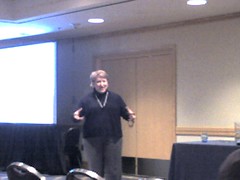Yesterday was embarrassing on so many different levels. The biggie was going into my workshop yesterday, prepared for an all day session, and discovering from the attendee that it would only last for three hours. I got it all in, but not nearly to the depth that I had hoped. The response was still positive, though I must admit some apprehension from the fact that long-time blogger, Ann Davis was in the audience. It “made the workshop,” though, being able to draw from her experience as a teacher of blogging students.
At the end of the session, as I was giving podcasting way to little time, I went around the audience asking, “Having learned a bit about Web 2.0, what does School 2.0 mean to you?” One person said that in School 2.0, students will have the freedom and opportunity to learn through their strengths. Differentiated instruction becomes differentiated learning. I’ve been calling this the Technology, Reading, and Learning Disabilities conference. I’d forgotten that they’ve changed the name to Technology, Reading, and Learning Diversity conference. I like that better.
 Another attendee came up to me in the lobby as we were waiting to get into the Ellin Keene keynote. She said that she didn’t know anything about Web 2.0 at the beginning of the workshop, but that she and her colleague had met during the afternoon, and now had a plan to have the students they work with at the university level blog about their experiences as students with diverse learning styles. It’s a story that’s not really been told, but one that’s talked a lot about here at the TRLD conference.
Another attendee came up to me in the lobby as we were waiting to get into the Ellin Keene keynote. She said that she didn’t know anything about Web 2.0 at the beginning of the workshop, but that she and her colleague had met during the afternoon, and now had a plan to have the students they work with at the university level blog about their experiences as students with diverse learning styles. It’s a story that’s not really been told, but one that’s talked a lot about here at the TRLD conference.
I must admit that I walked out of the keynote unimpressed. However, it is an A.D.D. thing that you’ve got to get things rolling around in your head before you come to fully understand something. It’s what woke me up early this morning, all that rolling in my head. Ellin Keene talked about just that, understanding. The title of the keynote was “To Understand.” A very good story teller, Keene shared some experiences that she had implementing a literacy program in the nations poorest school districts (first grade teachers shot by drive-bys, children having to spend the night in the gym because they can’t afford to bus them both ways, 40% of children without electricity at home, and 4% graduation rates). She told a story of a girl who apparently erupted in class at being asked one to many times, “Did that story you just read make sense?”
She said, “Everyone asks me, ‘does this make sense?’ Why don’t you tell me what make sense means?”
Keene said that this question changed her professional life, because she could not answer that question. What does it mean to understand something. Our answer, as educators, is, can you answer questions about it or can you retell the story.
She said, “That’s not understanding, that’s assessment!“
I felt like a rock hit me in the head when the implications of that statement finally coalesced. We seem to have completely lost sight of what it is that we are doing. We aren’t teaching for understanding. We’re teaching for testing. Well that’s not news to any of the readers of this blog. But the enormity of the waste and the enormity of the insult to our very bright children is mind-boggling to me at this moment.
Now, the reality of it is that many teachers are most definitely teaching for understanding. A number of conversations I’ve had with teachers and education leaders in the past couple of weeks have served to remind me of what a rich and nuanced act it is to teach. It’s humbling to me to be reminded that what I concentrate on, is only icing. It’s important icing, but its only one very thin layer of what it takes to be a good teacher in the best of times ——– in which we are not!
